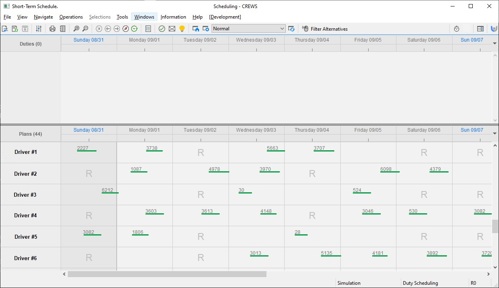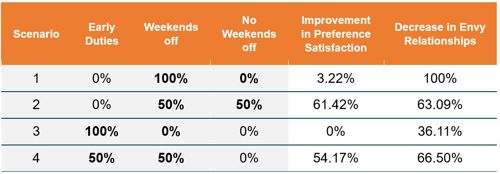
Ana Wemans, Software Engineer, and Ricardo Saldanha, Head of Innovation @SISCOG | 10 min read
___________
Improving employee attraction and retention is increasingly critical in a context where the railroad industry has been facing longstanding manpower shortages. This is why railroad operators value solutions to improve the work-life balance of their employees and empower them to influence how their work is scheduled.
Join us as we explain how workers can play an active role in designing their own work schedule without compromising the overall cost-efficiency of the work distribution among them.
THE PROPOSED SOLUTION
More precisely, we propose a solution for improving their work-life balance based on two principles:
a) allowing workers to express their own preferences in the form of requests; and
b) using algorithmic support to schedule the work aiming at maximizing the satisfaction of those preferences in a fair way. This algorithmic support is integrated into the Short-term Scheduler, a module of CREWS, one of the SISCOG Suite’s products, designed to schedule and manage the work of individual crew members, and other type of employees, for specific calendar dates (*).
![]() Empowering employees to actively express their preferences and shape their own work schedules.
Empowering employees to actively express their preferences and shape their own work schedules.
______________________
These preferences can be related to any characteristic of daily jobs, also known as duties, or related to days off, for example:
- Starting after 9 am every day to leave the kids at school before work
- Having a day off on a specific day to celebrate a birthday
- Leaving early on Wednesdays to spend more time with family
- Not having a day off on a holiday because of higher pay on holidays
Since it might be impossible to satisfy all preferences requested by the employees, they can indicate which of their requests are more valuable to them by assigning a weight to each request. It is also important to ensure that the satisfaction of the requests is done fairly, so that one employee is not favored in detriment of another.
This means that if two employees have similar requests, their satisfaction levels with the work assigned to them should be similar (we consider satisfaction levels defined by the weighted percentage of requests satisfied).
However, if two employees have completely different preferences, a fair work assignment may result in different satisfaction levels. For example, if one wants to work during the night and the other during the morning, it is not problematic or unfair if one is more satisfied than the other, since lowering the satisfaction of one wouldn’t benefit the other.
So far, the literature about satisfying preferences in the planning of personalized crew rosters focuses mainly on two approaches:
- One where employees have different preferences, but strict seniority is enforced, which means that workers choose their favorite rosters starting from the most senior, until the least senior gets the “leftovers”
- Another where all employees have the same preferences, which means that enforcing fairness is the same as imposing the same level of satisfaction for all employees.
What we want is a middle ground between these two approaches, where each employee can express their preferences and seniority is not strict. With our algorithmic procedure we distribute the work among the employees in a way that is cost-efficient, fair and maximizes their preferences as much as possible.
![]() Balancing seniority with individual preferences in crew rostering can lead to more equitable and efficient outcomes.
Balancing seniority with individual preferences in crew rostering can lead to more equitable and efficient outcomes.
______________________
The work to be distributed is given in the form of duties, as shown in Figure A. The result of distributing the work among employees is a set of crew rosters, one for each individual employee. These rosters can be regarded as sequences of duties interleaved with days off as shown in Figure B. Notice that these sequences must satisfy a set of labor rules that are taken from national labor law and from local agreements with the employees. In general, labor rules establish a minimum rest time between two consecutive duties, maximum average working hours, average days off per week, maximum consecutive working days, etc. As shown in Figure B, the roster sequences are defined as continuations of sequences defined for a previous period.

Figure A: CREWS Short-term Scheduler showing an unsolved problem with 324 unplanned duties (4 of them visible) and a set of 44 rosters (6 of them visible) that have duties assigned until Sunday 08/31 and no duties assigned from that date on.

Figure B: CREWS Short-term Scheduler showing the result of planning all duties referred in Figure A in the form of rosters, which are sequences of duties (represented with green lines) and days off (represented with letter “R”).
A TWO-STEP PROCESS
Our algorithmic procedure is a two-step process.
1º In the first step we calculate the expected satisfaction of each employee taking into consideration fairness and the degree of competitiveness of his requests with respect to his colleagues. This is done by simulating an auction where each employee has a fixed budget (which is the same for the same seniority level) and distributes his budget over bets on duties that satisfy his preferences. Based on the duties each employee was able to buy in the auction, satisfaction levels are calculated for each employee. These satisfaction levels are considered fair because the budget of each employee is the same for everyone in the same seniority level.
2º In the second step we produce optimized feasible crew rosters based on the satisfaction levels obtained in the first step. A large neighborhood search is used to improve an initial solution produced by a constructive greedy heuristic. The primary goal is to plan all duties, while the secondary goal is to minimize the average square deviation between the achieved and the expected satisfaction computed in the first step.
For more details about the algorithmic procedure, please refer to the paper(**) presented at the 15th International Conference on Advanced Systems in Public Transport (CASPT 2022).
In order to evaluate the fairness of a work assignment, we count the number of envy relationships found in the rosters of the employees. This key performance indicator (KPI) is inspired in the vast literature about fair division of indivisible goods (***). There is an envy relationship between employee A and employee B if A envies the roster of B. Employee A envies the roster of B if he is able to perform the roster of B and if he would rather perform that roster instead of his own because it will increase the satisfaction of his own preferences.
A TESTED APPROACH
To test our approach, we used real world data from one of the northern European railroads and set up several datasets. One of those datasets involves 32 employees with the same seniority level, 30 days of planning horizon and 734 duties to be planned. We tested 4 different preference scenarios where:
- all employees want to have the weekends off,
- half of the employees want the weekends off and the other half wants to work during the weekends,
- all employees want to work early duties and
- half of the employees want early duties while the other half wants weekends off.
In Table 1 we show the improvements obtained in average preference satisfaction and in envy relationships by considering preference satisfaction and by not considering it.
As we can see in all scenarios, there were significant improvements in the envy relationships, noting especially scenario 1 where envy was completely removed.
We also observe increases in improvements on preference satisfaction in situations where there is a decrease in competitiveness among employees. For instance, in scenario 2 the competitiveness is reduced to half with respect to 1 because only half of the employees compete for the same type of day off (duty).This results in an increase in preference satisfaction improvement of 61.42%. A similar behavior is observed when comparing scenario 4 with 3.
We can also observe that in scenarios where all employees compete for the same days off or duties (namely scenarios 1 and 3) there are improvements in terms of fairness but not in terms of preference satisfaction (or at least neglectable). This happens because, no matter how days off or duties are distributed among the employees, the average preference satisfaction is always the same (or almost the same).
In scenario 1 the improvement is not null (3%) because, although the number of weekends and the number of employees that can have a day off is limited, it is possible to swap reserve duties (duties that only have a start time and end time, but no content assigned) with days off. This allows for a slight improvement in the average preference satisfaction, although the resulting solution could be a little less robust to unforeseen circumstances.

Table 1: Improvements obtained in preference satisfaction and envy KPIs by using our approach.
![]() A collaborative approach that enhances both work-life balance and job satisfaction.
A collaborative approach that enhances both work-life balance and job satisfaction.
______________________
CONCLUSION
In conclusion, our algorithmic solution empowers employees to play an active role in the construction of their work schedules.
By allowing them to express both day-off and work-related preferences, this innovative solution not only allows employees to improve their work-life balance but also contributes to higher job satisfaction and retention.
For railroad operators, this translates into a more motivated workforce and smoother, more reliable transport operations.
As industries continue to face workforce shortages, adopting such solutions can be a game-changer in creating a collaborative and efficient work environment.
